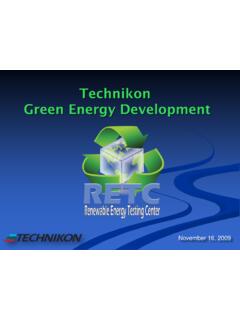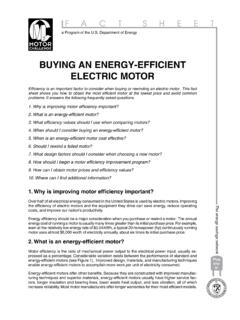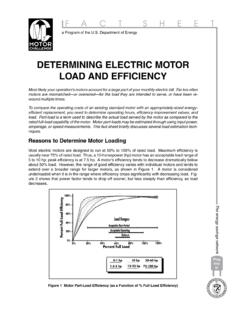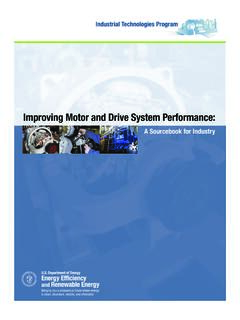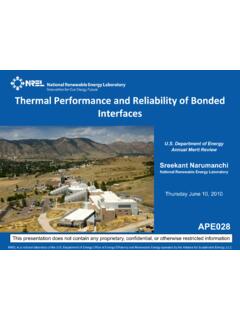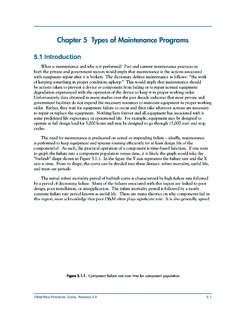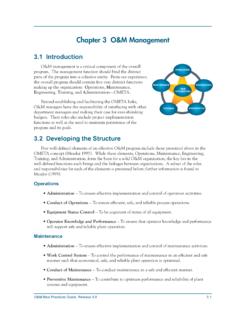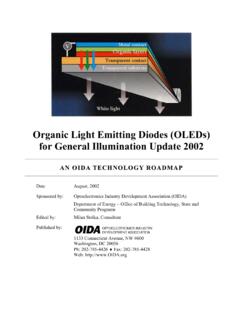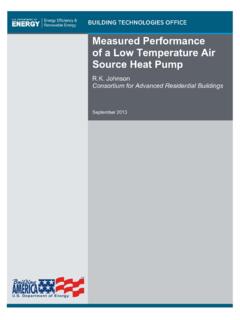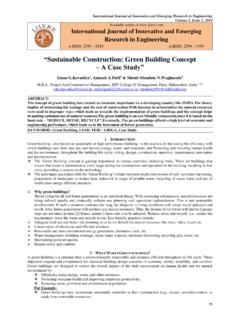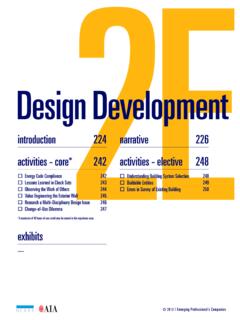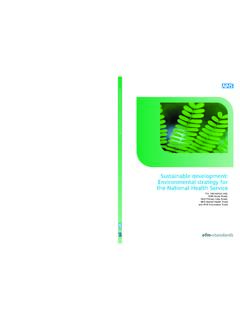Transcription of 2.0 The Economic Benefits of Sustainable Design - Energy
1 The Economic Benefits of Sustainable Design Evidence is growing that Sustainable buildings provide financial rewards for building owners, operators, and occupants. Sustainable buildings typically have lower annual costs for Energy , water, maintenance/repair, churn (reconfiguring space because of changing needs), and other operating expenses. These reduced costs do not have to come at the expense of higher first costs. Through integrated Design and innovative use of Sustainable materials and equipment, the first cost of a Sustainable building can be the same as, or lower than, that of a traditional building. Some Sustainable Design features have higher first costs, but the payback period for the incremental investment often is short and the lifecycle cost typically lower than the cost of more traditional buildings.
2 In addition to direct cost savings, Sustainable buildings can provide indirect Economic Benefits to both the building owner and society. For instance, Sustainable building features can promote better health, comfort, well-being, and productivity of building occupants, which can reduce levels of absenteeism and increase productivity. Sustainable building features can offer owners Economic Benefits from lower risks, longer building lifetimes, improved ability to attract new employees, reduced expenses for dealing with complaints, less time and lower costs for project permitting resulting from community acceptance and support for Sustainable projects, and increased asset value.
3 Sustainable buildings also offer society as a whole Economic Benefits such as reduced costs from air pollution damage and lower infrastructure costs, , for avoided landfills, wastewater treatment plants, power plants, and transmission/distribution lines. Section explains how using integrated Design and various low-cost Sustainable features reduces first costs. Sections through discuss the other direct Economic Benefits : annual operating cost savings for Energy , water, maintenance and repair, and churn. Sections and discuss the indirect Benefits of Sustainable buildings for building owners, and Section discusses the indirect Benefits of Sustainable buildings for society.
4 Case studies and research summaries illustrating various Benefits are included in each section. Lower (or Equal) First Costs Sustainable Design must begin at the conceptual stage of a project to realize the full Benefits . The first step is to form a Design team including the owners; architects; engineers; Sustainable Design consultants; landscape designers; O health, safety and security experts; the general contractor and "As the green Design field matures, it becomes key subcontractors; cost consultants and value ever more clear that integration is the key to achieving Energy and environmental goals engineers; and occupant representatives. This team especially if cost is a major driver.
5 ". needs to work together from the start, seeking an "integrated" Design . The team develops innovative Building Green Inc. (1999). solutions that meet Energy , environmental, and social goals while keeping costs within budget. Using their collective, interdisciplinary analytical capability, the team can incorporate many strategies that, taken alone, would increase first costs. For example, by improving the building envelope, the Design team can often eliminate the heating, ventilation, and air conditioning (HVAC) system around the perimeter of the building (and the associated ducting) and also downsize the primary HVAC system. Downsizing the HVAC system and eliminating ducting release money to pay for the envelope improvements.
6 A good example of this phenomenon occurred during the 2-1. Design of the Pennsylvania Department of Environmental Protection's Cambria Office Building. When designers of this building first proposed an upgrade to triple-glazed, double low-e windows, the developer balked at the $15,000 increase in cost. However, the developer was won over when it was demonstrated that this upgrade would allow the perimeter-heating zone to be eliminated for a savings of $15,000, the heat pumps to be downsized for an additional $10,000 savings, and additional space to be gained because of the smaller equipment and ducts for additional rent of $5, Also, by eliminating unnecessary features ( , expensive finishes), the team can add some more expensive Sustainable features that not only meet environmental goals but that also reduce operating costs.
7 In a Sustainable Design project, the Design team conducts a tradeoff exercise trading off the cost of optional features against the cost of features that will result in Energy , environmental, or social improvements. Focusing on integrated solutions and explicitly evaluating tradeoffs can result in a Sustainable facility built for the same (or an even lower) cost than a more traditional building. In most of the government case studies of Sustainable buildings included in this document, the first costs were not higher than the original budgeted amount. The following are some Design and construction strategies that a team can use to reduce first costs:9. Optimize site and orientation.
8 One obvious strategy to reduce first costs is to apply appropriate siting and building orientation techniques to capture solar radiation for lighting and heating in winter and shade the building using vegetation or other site features to reduce the summer cooling load. Fully exploiting natural heating and cooling techniques can lead to smaller HVAC systems and lower first costs. Re-use/renovate older buildings and use recycled materials. Re-using buildings, as well as using recycled materials and furnishings, saves virgin materials and reduces the Energy required to produce new materials. Re-using buildings may also reduce time (and therefore money). associated with site planning and permitting.
9 Reduce project size. A Design that is space-efficient yet adequate to meet the building objectives and requirements generally reduces the total costs, although the cost per unit area may be higher. Fully using indoor floor space and even moving certain required spaces to the exterior of the building can reduce first costs considerably. Eliminate unnecessary finishes and features. One example of eliminating unnecessary items is choosing to eliminate ornamental wall paneling, doors (when privacy isn't critical), and drop . ped ceilings. In some cases, removing unnecessary items can create new opportunities for designers. For example, eliminating dropped ceilings might allow deeper daylight penetration and reduce floor-to-floor height (which can reduce overall building dimensions).
10 Avoid structural overdesign and construction waste. Optimal value engineering and advanced framing techniques reduce material use without adversely affecting structural Designing to minimize construction debris ( , using standard-sized or modular materials to avoid cutting pieces and generating less construction waste) also minimizes labor costs for cutting materials and disposing of waste. 8. "Pennsylvania Department of Environmental Protection's Cambria Office (DEP Cambria)," a case study in DOE's High Performance Buildings Database at 9. Many of these concepts were outlined in "Building Green on a Budget." Article found at , which cites Environmental Building News (May 1999), a newsletter published by Building Green at 10.
